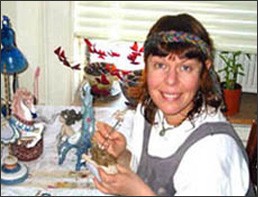Luel Restoration Studio — Home
China, originally referred to a ceramic dinnerware coming out of the country of China, was particularly fine and exceptionally white.
China is a ceramic product but of a very fine quality and it should more accurately be called porcelain. The Chinese perfected porcelain by using kaolin, a white clay, mixing it with china stone and firing it at high temperatures. That was in the 10th century and it took another 800 years before true porcelain was developed in Europe.
Early Europeans tried to duplicate Chinese porcelain and the results were soft paste porcelain made with clays and silicates. In the 1700s, a German pottery company successfully produced bone china, which is similar to true porcelain, by mixing calcified bones, clay, and feldspar. Bone china is extremely strong and easy to make, and it became very popular among the English speaking nations. However, true porcelain is preferred in much of Europe and Asia.
True porcelain is a hard, fine-grained, sonorous, nonporous, and usually translucent and white ceramic ware that consists essentially of kaolin, quartz, and a feldspathic rock and is fired at a high temperature —called also hard-paste porcelain.
In China, porcelain is defined as pottery that is resonant when struck; in the West it is a material that is translucent when held to the light. Neither definition is totally correct. Some heavily potted porcelains are opaque, while some thinly potted stonewares are sometimes translucent.
Porcelain Repair
The trick in china plate restoration (china repair) is to be able to match the surface texture in such a way that it doesn’t differ from the original when held up to the light or gently struck. Airbrushing and glazing are two of the most important step in restoring china (or true porcelain), soft-paste porcelain and bone china. Glaze, a glass-like substance originally used to seal a porous pottery body is used solely for decoration on true(hard-paste) porcelain. A lot of inexperienced china restorers use too much glaze to cover their sculpting mistakes, thereby rendering the restored part more opaque than what it was originally.
Airbrushing the matched and replicated design in cold restoration requires painstaking effort. Painted decorations are executed over the fired glaze. Because painting under the glaze must be fired at the same high temperatures as the body, many colors and designs would get distorted or simply “fire away”. That’s why underglaze painting is limited to the extremely stable and reliable cobalt blue, which is found in most Chinese blue-and-white wares. These days most porcelain colors and designs are painted over the glaze and they are not as vivid and precise as the underglaze designs; therefore a restorer involved in porcelain repair and restoration is required to be very precise and patient.
For more on china restoration and porcelain repair, and to see the before and after photos of the two-inch Ming Dynasty wine cup Luba just restored for a New York City collector click here…


Speak Your Mind